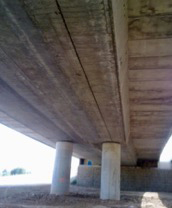ESR11: Development of optical fibre distributed sensing for 
SHM of bridges and large scale structures
- Host: Universitat Politècnica de Catalunya (UPC)
- Address: School of Civil Engineering, c/Jordi Girona 1-3. Campus Nord. Modul C1, 08034 Barcelona, Spain.
- Main Supervisor: Prof. Joan Ramon Casas
- Fellow: António Barrias
The technique of fibre optic sensors has been used in Structural Health Monitoring (SHM) for 30 years. Over these years, the technique has been developed until obtaining measures with accuracy similar to the standard strain gages and extensometers. The use of Optical Backscatter Reflectometry (OBR) is a promising measurement technology for Structural Health Monitoring (SHM) as it offers the possibility of continuous monitoring of strain and temperature along the whole fibre in comparison with local sensor placement (as the Bragg gratings).
OBR differs from other frequency-domain techniques in that it is sensitive enough to measure levels of Rayleigh backscatter in standard single-mode fibre. Several applications to materials used in the aeronautical construction have demonstrated the feasibility of such technique. These materials (composites, steel, aluminium), apart from having a smooth surface where the bonding of the sensor is easily carried out, they also have a continuous strain field when subject to external loading.
The feasibility of using OBR in SHM of civil engineering constructions made of concrete is even of greater interest, mainly because in this type of structures it is impossible to know where the cracks may appear and therefore severe cracking (dangerous for the structure operation) can appear without warning if local measuring sensors are not placed in the particular location where the crack appears.
UPC will work with Crack Ingenieria to overcome some limitations in the application of such type of sensor to concrete structures such as (1) the roughness of the concrete surface and the heterogeneity due to the presence of aggregates of several sizes, and (2) the fact that reinforced concrete cracks at very low level of load, appearing as a discontinuity in the surface and the strain field that may provoke a break or debonding of the optical fibre. This technology has the ability to test a structure over extended gauge lengths.
You can follow blog and publications by ESR11 below.



